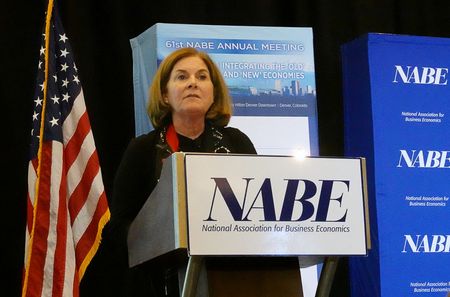By Howard Schneider
WASHINGTON (Reuters) – Kansas City Federal Reserve President Esther George has urged her colleagues to come to terms “earlier than later” on a plan for the U.S. central bank to exit the mortgage-backed securities (MBS) market and be more explicit on how bond purchases will figure into future monetary policy.
“You can’t just wake up one day and say, ‘hey, we’re going to get out of this business,'” George, who is retiring from her position at the end of this month, told Reuters in an interview published on Monday.
She noted that Fed officials agree in principle that the central bank’s securities portfolio should only include those assets issued by the U.S. Treasury – not those backed by home mortgages – but don’t yet have a plan to get there.
The Fed currently holds about $2.6 trillion of MBS as part of its roughly $8 trillion securities portfolio. That is about a quarter of the total MBS market, what George referred to as an “enormous” share that raises questions about the appropriate extent of the central bank’s presence.
George, whose last day before retiring is Jan. 31, will not participate in the Jan. 31-Feb. 1 policy meeting. She spoke to Reuters before the start last Saturday of the “blackout” period that restricts Fed officials from making public comments about policy in the run-up to meetings.
The Fed is trying to reduce its balance sheet overall as part of the plan to tighten monetary policy, and is allowing up to $60 billion a month in Treasury securities and $35 billion in MBS to mature and “run off” from its holdings.
In theory, that puts upward pressure on long-term interest rates by lowering demand for those assets.
But, in the case of MBS, high interest rates also slow the pace of the run-off since it discourages both the home sales and the refinancings that, because existing mortgages get paid off, decrease the principal of MBS quicker than would occur only through monthly payments by homeowners.
‘NOT IN MY DNA’
Since the Fed began to let its balance sheet decline in June, its MBS holdings have fallen by about $67 billion, or roughly 2.5%, a pace that would leave the central bank in the mortgage market for years to come. Several Fed officials have said the central bank will eventually need to sell its MBS holdings.
George said she did not have a specific plan in mind, but felt her colleagues should get to work on one.
“At some point people will have to address: is that the footprint we want in the mortgage market?” George said of the current holdings. More important than the details of any plan “is just to say how will we go about doing that earlier rather than later. There could be many combinations of things that get you there.”
George, 65, has been head of the Kansas City Fed since October 2011. She has been among the central bank’s more frequent dissenters, and a particular skeptic of both quantitative easing – the use of bond purchases to support markets and the economy – and the 2% inflation target adopted shortly after her arrival.
“I’ve never felt comfortable saying we should want inflation. It’s not in my DNA,” said George, whose roots are in Midwestern family farming, an industry that was particularly damaged by the high-inflation, high-interest-rate environment of the 1970s and 1980s.
‘OUT OF THE BOX’
George said she feels the Fed’s balance sheet continues to get “too little attention” in terms of how the central bank’s slow withdrawal from long-term securities markets could, for example, influence the yield curve given the fast hikes in U.S. short-term interest rates delivered last year.
The Fed hiked its benchmark overnight interest rate by 4.25 percentage points in 2022 to tame inflation that had surged to 40-year highs. It is widely expected next week to raise that rate by a quarter of a percentage point to the 4.50%-4.75% range.
More broadly, George said, after twice launching bond purchases to support the economy, once following the 2007-2009 financial crisis and recession, and again at the onset of the COVID-19 pandemic after interest rates were cut to the near-zero level, she said the central bank should develop clearer guidelines for when the purchases are to be used, and what impact on the economy they are seen to have.
During the pandemic, for example, the Fed was buying MBS and, in theory, pushing down mortgage rates, even though house prices were skyrocketing.
Given that the Fed now uses its balance sheet to manage the short-term policy rate of interest, George feels it would be difficult, at the least, to return to the limited holdings the Fed had prior to the 2007 housing market meltdown.
But she said her time on the central bank’s policy-setting Federal Open Market Committee has not convinced her that bond purchases have much influence beyond inflating asset values – something future policymakers should confront.
Quantitative easing “is out of the box and now future committees will have to think about how to manage it,” George said. “I think economists have a lot more work to do on understanding this instrument. I think a lot of time was spent defending what its benefits were. I think too little attention has been paid to its consequences.”
(Reporting by Howard Schneider; Editing by Dan Burns and Paul Simao)


